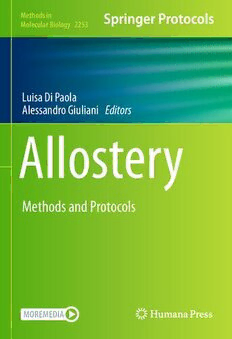Table Of ContentMethods in
Molecular Biology 2253
Luisa Di Paola
Alessandro Giuliani Editors
Alloster y
Methods and Protocols
M M B
ETHODS IN OLECULAR IO LO GY
SeriesEditor
JohnM.Walker
School of Lifeand MedicalSciences
University ofHertfordshire
Hatfield, Hertfordshire, UK
Forfurther volumes:
http://www.springer.com/series/7651
For over 35 years, biological scientists have come to rely on the research protocols and
methodologiesinthecriticallyacclaimedMethodsinMolecularBiologyseries.Theserieswas
thefirsttointroducethestep-by-stepprotocolsapproachthathasbecomethestandardinall
biomedicalprotocolpublishing.Eachprotocolisprovidedinreadily-reproduciblestep-by-
step fashion, opening with an introductory overview, a list of the materials and reagents
neededtocompletetheexperiment,andfollowedbyadetailedprocedurethatissupported
with a helpful notes section offering tips and tricks of the trade as well as troubleshooting
advice. These hallmark features were introduced by series editor Dr. John Walker and
constitutethekeyingredientineachandeveryvolumeoftheMethodsinMolecularBiology
series. Tested and trusted, comprehensive and reliable, all protocols from the series are
indexedinPubMed.
Allostery
Methods and Protocols
Edited by
Luisa Di Paola
Unit of Chemical-Physics Fundamentals in Chemical Engineering, Department of Engineering, Universitá
Campus Bio-Medico di Rome, Rome, Italy
Alessandro Giuliani
Environment and Health Department, Instituto Superiore di Sanità, Rome, Italy
Editors
LuisaDiPaola AlessandroGiuliani
UnitofChemical-PhysicsFundamentals EnvironmentandHealthDepartment
inChemicalEngineering InstitutoSuperiorediSanita`
DepartmentofEngineering Rome,Italy
Universita´Campus
Bio-MedicodiRome
Rome,Italy
ISSN1064-3745 ISSN1940-6029 (electronic)
MethodsinMolecularBiology
ISBN978-1-0716-1153-1 ISBN978-1-0716-1154-8 (eBook)
https://doi.org/10.1007/978-1-0716-1154-8
©SpringerScience+BusinessMedia,LLC,partofSpringerNature2021
Thisworkissubjecttocopyright.AllrightsarereservedbythePublisher,whetherthewholeorpartofthematerialis
concerned,specificallytherightsoftranslation,reprinting,reuseofillustrations,recitation,broadcasting,reproduction
onmicrofilmsorinanyotherphysicalway,andtransmissionorinformationstorageandretrieval,electronicadaptation,
computersoftware,orbysimilarordissimilarmethodologynowknownorhereafterdeveloped.
Theuseofgeneraldescriptivenames,registerednames,trademarks,servicemarks,etc.inthispublicationdoesnotimply,
evenintheabsenceofaspecificstatement,thatsuchnamesareexemptfromtherelevantprotectivelawsandregulations
andthereforefreeforgeneraluse.
Thepublisher,theauthors,andtheeditorsaresafetoassumethattheadviceandinformationinthisbookarebelievedto
betrueandaccurateatthedateofpublication.Neitherthepublishernortheauthorsortheeditorsgiveawarranty,
expressedorimplied,withrespecttothematerialcontainedhereinorforanyerrorsoromissionsthatmayhavebeen
made.Thepublisherremainsneutralwithregardtojurisdictionalclaimsinpublishedmapsandinstitutionalaffiliations.
ThisHumanaimprintispublishedbytheregisteredcompanySpringerScience+BusinessMedia,LLC,partofSpringer
Nature.
Theregisteredcompanyaddressis:1NewYorkPlaza,NewYork,NY10004,U.S.A.
Preface
Proteinsareattheinterfacebetweensimpleandcomplexsystemsasaptlysynthesizedsome
yearsagoinanenlighteningpaperbyHansFrauenfelderandPeterWolynes(Frauenfelder,
Hans,andPeterG.Wolynes.“Biomolecules:wherethephysicsofcomplexityandsimplicity
meet.”PhysicsToday;(UnitedStates)47.2(1994)).Thispeculiarpositionmakesthestudyof
protein structure and dynamics as the most convenient vantage points were to look at all
those features like self-organization, signal/noise discrimination, specificity of interaction,
multiple equilibria that are not present in organic molecules (whose behavior can be
satisfactorily faced by standard chemo-physical approaches) and that are too difficult to
graspandanalyzeinbiologicalsystems(whosebehavioremergesfromanondecomposable
mixtureoftop-downandbottom-upregulations).Itisnotwithoutmeaningthatoneofthe
most influential journals in protein scienceisBiophysical Chemistrythat in thetitle embeds
thethreemostcentralfieldsofnaturalscience.
The investigation in protein science stems from very reliable data coming from the
“simplicity” end (atomic coordinates of protein structures from X-ray crystallography,
chemo-physicalpropertiesofaminoacidresidues)andgoesintothe“complexity”territories
ofthediscriminationofrelevant“signals”fromthermalnoiseinthecaseofallosteryor the
conundrumofthestructure–functionrelationinnativelyunfoldedproteins.
This creates a perfect playground to explore the “mesoscopic realm” (Laughlin, R. B.,
Pines,D.,Schmalian,J.,Stojkovic´,B.P.,&Wolynes,P.(2000).Themiddleway.Proceedings
oftheNationalAcademyofSciences,97(1),32-37.)wherethestilllargelyunknownorgani-
zationprinciplesorderingthemiddle-scalebetweenatomsandgalaxiesarehidden.
This very ambitious goal is (more or less) latent in all book chapters that rebound
around the two basic issues of “allostery” and “network” that are present in almost all the
chapter titles. These two issues are each other connected by the fact that proteins are the
mostbasic“machine-like”objectssharingwithhuman-mademachinetheneedtoorganize
theirarchitecturetoapurposethatpertainstoadifferentorganizationlayer.Itisconvenient
to talk of a “purpose” more than a “function” (that is present even in simpler systems) for
the same reason that differentiates an isolated piston (whose function is to transform the
energycomingfromoilexplosionintoarhythmicmotion)fromtheentirecarthatneedsto
integrate the different functions of its parts into a coherent whole. At odds with a car, a
protein accomplishes its goal (e.g., to transport oxygen from lungs to tissues along blood
flow) without a driver, thus it must take care of self-organizing according to its micro-
environment (e.g., lowering its affinity constant for oxygen in the peripheral tissues and
increasingtheaffinityinthelungs).Thisimpliestheneedofasensor–control–effectorcircuit
like any self-adjusting device; these three tasks correspond to concerted changes of the
wholeconfigurationthatstartfromasensorand endupattheeffector that isexactlywhat
“allostery”isfor:sensingarelevantstimulus,transportingtheinformationacrosstheentire
structure,andchangingtheconfigurationaccordingly.
In order to do so, the protein must have a wiring architecture that allows to both
discriminate relevant signals by thermal noise (in a situation where signal-to-noise ratio is
near unity in energetic terms) and make the signal to reach the correct effector (e.g., the
active site). This wiring architecture can profitably be interpreted in terms of a “network”
whosenodesareaminoacidresiduesandlinkstheeffectivecontactsbetweenthem,andthe
v
vi Preface
investigationofthefeaturesofthenetworkarchitecturecanshedlightonthedynamicsand
efficacy of allosteric control and open the way to a completely new avenue of therapeutic
intervention. The general paradigm of proteins as “self-organizing” machines is the “red
line,”unifyingallthedifferentchaptersofthebook.
InChapter1,theauthorsputintoanhistoricalperspectivetheproblemofallosteryand
demonstrate how this issue constitutes the basic issue to give a scientific foundation to
biology freeing the life science to invoke “Maxwell demons” to get rid of the otherwise
impossibletounderstandextremespecificityofcellmetabolism.
Chapter 2 has a methodological/computational flavor focusing on the necessary link
betweenallosteryandnetworkformalism.
Guang Hu in Chapter 3 presents a rigorous way to “dynamize” structural network by
consideringtheirlinksassprings,andthismodelingchoiceallowstosimulatetheallosteric
behavioroftheproteinmolecules.
Chapter4goesindepthintotheenergeticfeaturesofallostery.Theauthorsareableto
establish a link between the presence of oscillating modes traversing the structure and the
underlyingnetworkwiring,thusgivingaphysicallymotivatedpictureofallostericprocess.
AdnanSljoka,inChapter5,proposesamechanicalperspectivefortheelucidationofthe
“secondsecretoflife”(asuggestivebutverywell-motivateddefinitionofallostery)interms
ofrigidityperturbation.
Chapter 6 (apparently) deals with another theme that is the nature of protein–protein
interaction,andthisissueasksfortheconsiderationofcooperativeeffectsthatareatthevery
basisofanykindofsignaltransductionacrossproteinstructures.
The convergence between protein–protein interaction and allostery is clarified in
Chapter7.Bothallosteryandprotein–proteininteractionrelyonthesharedneedofcontact
networkrewiringthatisattheverybasisofanymotionofthe“proteinmachines.”
Chapter 8 is a reprise of the methodological line of reasoning of Chapter 2, going in
depth into the presence of “sub-networks” (domains) of global contact network and
introducing the crucial issue of “assortativity” that generates that breaks the symmetry of
contactsdistributioncreating“specializedspatialpatches”inproteinterritory.
The “symmetry breaking” introduced by Lesieur and Vuillon in Chapter 8 is further
analyzedinChapter9,describingamethodthatcombinestheinformationonthecorrelated
proteinmotionsresultingfromatomisticMDsimulationswithanetworkanalysisbasedon
graphpartitioningintomutuallyexclusivegroups,namedcommunities.
Chapter 10 introduces a software suite designed to analyze molecular dynamics and
structuralensemblesinanetworkperspectiveallowingtoconjugatethethreemaindimen-
sionsofproteinscience:dynamical,structural,andchemical,allowingthedifferentclassesof
intra-andintermolecularinteractionstoberepresented,combined,oraloneintheformof
interactiongraphsstartingfrommoleculardynamicstrajectories.
Chapter 11 faces the most paradigmatic case of interaction specificity in biomedicine:
the antigen–antibody recognition in terms of allostery allowing the reader to grasp the
fundamentalroleofthisphenomenoninlifesciences.
The “action at distance” by the transduction of signal across an organized network
structureisboththethemeofChapter12andthefundamental“recipe”oflivingentitiesat
themolecularlevel.
The central position of allosteric-like signal transduction is the focus of Chapter 13,
dealingwiththeprobablymostfamous(andstudied)hubprotein.P53locatedatthecross-
road of cell cycle regulation, genome integrity, and cancer development. Elena Papaleo in
Preface vii
thischapterasksfortheneedforafreshapproachtothestudyofthisprotein,encompassing
amoreintegratedandsystemicattitude.
Chapter 14 introduces the most direct applicative dimension of the network-based
approaches to allostery, introducing a totally new approach to pharmacology: allosteric
drug paradigm that promises to make pharmacological research to exit from a bottleneck
lastingsinceatleasttwodecades.
Chapter15constitutesa(largelyunexpected)wideningoftheperspectivetellingusnot
onlyproteinsbutevenRNAsystemsdisplayallostericandcooperativefeatures.Besidesthe
applicative value for exploiting gene expression regulation, these findings open the way to
verystimulatinghypothesesaboutanRNAworldattheveryoriginoflife.
Wecansafelystatethattheauthorscontributingtothisbookarerepresentativesofthe
frontiers of integrated approaches to protein science and the picture emerging is in turn
coherentandfullyintegrated,thuscontributingtotherecoveryfromthefragmentationof
scientificthoughtthatisprobablythemostdangerousmenacefacingscienceinthesetimes.
Rome,Italy LuisaDiPaola
AlessandroGiuliani
Contents
Preface ..................................................................... v
Contributors................................................................. xi
1 Allostery:TheReboundofProteins....................................... 1
AlessandroFinazziAgro` andGiampieroMei
2 DisclosingAllosteryThroughProteinContactNetworks .................... 7
LuisaDiPaola,GiampieroMei,AlmerindaDiVenere,
andAlessandroGiuliani
3 IdentificationofAllostericEffectsinProteinsbyElastic
NetworkModels........................................................ 21
GuangHu
4 LocatingandNavigatingEnergyTransportNetworksinProteins............. 37
KoreyM.ReidandDavidM.Leitner
5 ProbingAllostericMechanismwithLong-RangeRigidity
TransmissionAcrossProteinNetworks .................................... 61
AdnanSljoka
6 ProteinAssembly:DefiningtheStrengthofProtein-Protein
InteractionsCouplingtheTheorywithExperiments ........................ 77
GiampieroMei,AlmerindaDiVenere,LuisaDiPaola,
andAlessandroFinazziAgro`
7 NetworkRe-WiringDuringAllosteryandProtein-Protein
Interactions:AGraphSpectralApproach................................... 89
VasundharaGadiyaram,AnasuyaDighe,SambitGhosh,
andSaraswathiVishveshwara
8 TopologyResultsonAdjacentAminoAcidNetworks
ofOligomericProteins .................................................. 113
ClaireLesieurandLaurentVuillon
9 CommunityNetworkAnalysisofAllostericProteins......................... 137
IvanRivaltaandVictorS.Batista
10 ThePyInteraphWorkflowfor theStudyofInteractionNetworks
FromProteinStructuralEnsembles ....................................... 153
MatteoLambrughi,ValentinaSora,andMatteoTiberti
11 TheAllostericEffectinAntibody-AntigenRecognition...................... 175
JunZhao,RuthNussinov,andBuyongMa
12 DistalRegionsRegulateDihydrofolateReductase-Ligand
Interactions ............................................................ 185
MelanieGoldsteinandNinaM.Goodey
13 InvestigatingConformationalDynamicsandAllosteryin
thep53DNA-BindingDomainUsingMolecularSimulations................ 221
ElenaPapaleo
ix
x Contents
14 MolecularDynamicsSimulationTechniquesasToolsin
DrugDiscoveryandPharmacology:AFocusonAllostericDrugs............. 245
ChiaraBiancaMariaPlataniaandClaudioBucolo
15 CooperativityandAllosteryinRNASystems ............................... 255
AllaPeselisandAlexanderSerganov
Index ...................................................................... 273

